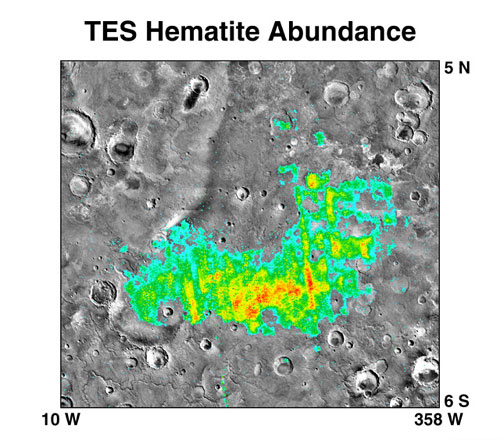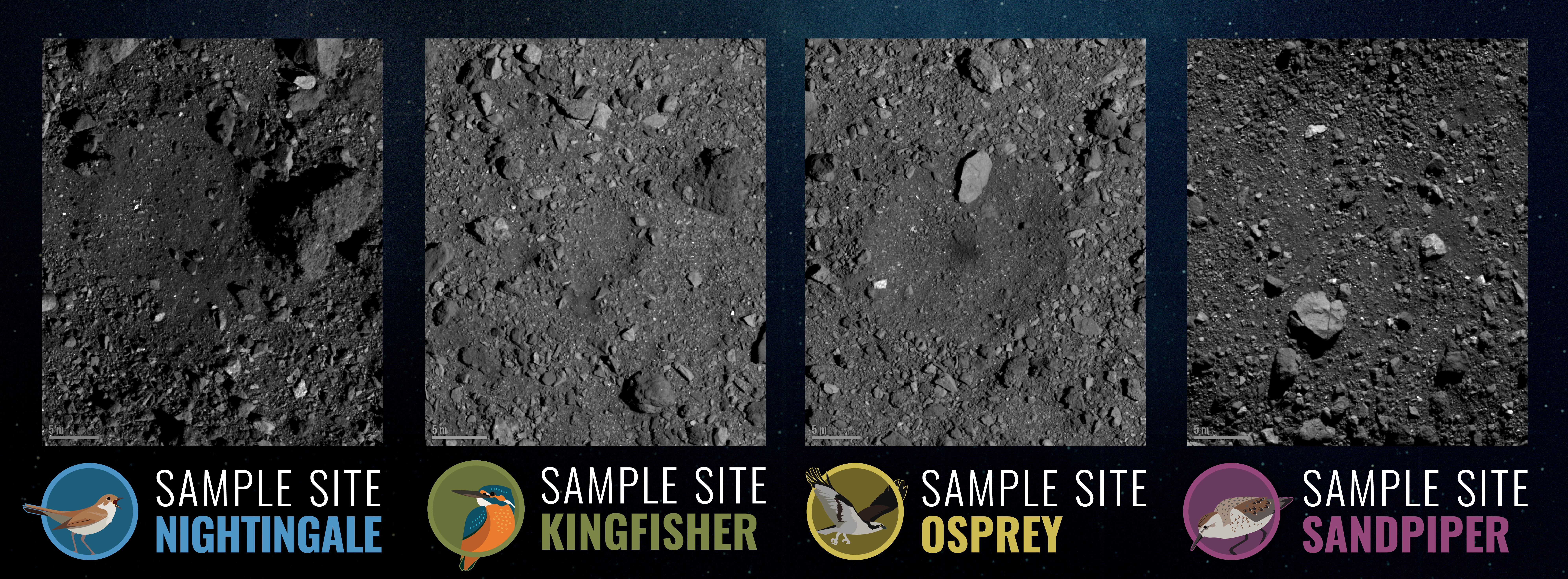|
Mars Space Flight Facility
The Mars Space Flight Facility is located at Arizona State University in Tempe, Arizona. The facility is a research center in Arizona State University's School for Earth and Space Exploration. Scientists, researchers, and students there specialize in using instruments on spacecraft at Mars for remote sensing research primarily concerning the geology and mineralogy of the planet. The instruments based at the facility include the Thermal Emission Imaging System (THEMIS) on NASA's Mars Odyssey orbiter and two Miniature Thermal Emission Spectrometers (Mini-TES) on the Mars Exploration Rovers, Spirit and Opportunity. (A full-size Mars rover model, bedded on reddish-brown sand, dominates the building's lobby.) Before the loss of NASA's Mars Global Surveyor in November 2006, the facility also operated the Thermal Emission Spectrometer (TES) aboard the spacecraft. On May 25, 2011, NASA announced a New Frontiers Mission, OSIRIS-REx, to a carbonaceous asteroid. The mission will include OT ... [...More Info...] [...Related Items...] OR: [Wikipedia] [Google] [Baidu] |
Arizona State University
Arizona State University (Arizona State or ASU) is a public university, public research university in Tempe, Arizona, United States. Founded in 1885 as Territorial Normal School by the 13th Arizona Territorial Legislature, the university is one of the List of United States university campuses by enrollment, largest public universities by enrollment in the United States. It was one of about 180 "normal schools" founded in the late 19th century to train teachers for the rapidly growing public common schools. Some closed, but most steadily expanded their role and became state colleges in the early 20th century, then state universities in the late 20th century. One of three universities governed by the Arizona Board of Regents, Arizona State University is a member of the Association of American Universities (AAU) and is Carnegie Classification of Institutions of Higher Education, classified among "R1: Doctoral Universities – Very High Research Activity". ASU has over 183,000 st ... [...More Info...] [...Related Items...] OR: [Wikipedia] [Google] [Baidu] |
Tempe, Arizona
Tempe ( ; ''Oidbaḍ'' in O'odham language, O'odham) is a city in Maricopa County, Arizona, United States, with the Census Bureau reporting a 2020 population of 180,587. The city is named after the Vale of Tempe in Greece. Tempe is located in the East Valley (Phoenix metropolitan area), East Valley section of Phoenix metropolitan area, metropolitan Phoenix; it is bordered by Phoenix, Arizona, Phoenix and Guadalupe, Arizona, Guadalupe on the west, Scottsdale, Arizona, Scottsdale and the Salt River Pima–Maricopa Indian Community on the north, Chandler, Arizona, Chandler on the south, and Mesa, Arizona, Mesa on the east. Tempe is the location of the main campus of Arizona State University. History The Hohokam lived in this area and built canals to support their agriculture. They abandoned their settlements during the 15th century, with a few individuals and families remaining nearby. Fort McDowell, Arizona, Fort McDowell was established approximately northeast of present dow ... [...More Info...] [...Related Items...] OR: [Wikipedia] [Google] [Baidu] |
Mars
Mars is the fourth planet from the Sun. It is also known as the "Red Planet", because of its orange-red appearance. Mars is a desert-like rocky planet with a tenuous carbon dioxide () atmosphere. At the average surface level the atmospheric pressure is a few thousandths of Earth's, atmospheric temperature ranges from and cosmic radiation is high. Mars retains some water, in the ground as well as thinly in the atmosphere, forming cirrus clouds, frost, larger polar regions of permafrost and ice caps (with seasonal snow), but no liquid surface water. Its surface gravity is roughly a third of Earth's or double that of the Moon. It is half as wide as Earth or twice the Moon, with a diameter of , and has a surface area the size of all the dry land of Earth. Fine dust is prevalent across the surface and the atmosphere, being picked up and spread at the low Martian gravity even by the weak wind of the tenuous atmosphere. The terrain of Mars roughly follows a north-south ... [...More Info...] [...Related Items...] OR: [Wikipedia] [Google] [Baidu] |
Thermal Emission Imaging System
The Thermal Emission Imaging System (THEMIS) is a camera on board the 2001 Mars Odyssey orbiter. It images Mars in the visible and infrared parts of the electromagnetic spectrum in order to determine the thermal properties of the surface and to refine the distribution of minerals on the surface of Mars as determined by the Thermal Emission Spectrometer (TES). Additionally, it helps scientists to understand how the mineralogy of Mars relates to its landforms, and it can be used to search for thermal hotspots in the Martian subsurface. THEMIS is managed from the Mars Space Flight Facility at Arizona State University and was built by the Santa Barbara Remote Sensing division of Raytheon, Raytheon Technologies Corporation, an American multinational corporation, multinational list of conglomerates, conglomerate headquartered in Waltham, Massachusetts. The instrument is named after Themis, the goddess of justice in ancient Greek mythology. Infrared camera THEMIS detects thermal ... [...More Info...] [...Related Items...] OR: [Wikipedia] [Google] [Baidu] |
Mars Odyssey
''2001 Mars Odyssey'' is a robotic spacecraft orbiting the planet Mars. The project was developed by NASA, and contracted out to Lockheed Martin, with an expected cost for the entire mission of US$297 million. Its mission is to use spectrometers and a thermal imager to detect evidence of past or present water and ice, as well as study the planet's geology and radiation environment. The data ''Odyssey'' obtains is intended to help answer the question of whether life once existed on Mars and create a risk-assessment of the radiation that future astronauts on Mars might experience. It also acts as a relay for communications between the ''Curiosity'' rover, and previously the Mars Exploration Rovers and ''Phoenix'' lander, to Earth. The mission was named as a tribute to Arthur C. Clarke, evoking the name of his and Stanley Kubrick's 1968 film '' 2001: A Space Odyssey''. ''Odyssey'' was launched April 7, 2001, on a Delta II rocket from Cape Canaveral Air Force Station, and ... [...More Info...] [...Related Items...] OR: [Wikipedia] [Google] [Baidu] |
Minites
The Miniature Thermal Emission Spectrometer (Mini-TES) is an infrared spectrometer used for detecting the composition of a material (typically rocks) from a distance. By making its measurements in the thermal infrared part of the electromagnetic spectrum, it has the ability to penetrate through the dust coatings common to the Martian surface which is usually problematic for remote sensing observations. There is one on each of the two Mars Exploration Rovers. Development The Mini-TES was originally developed by Raytheon for the Department of Geological Sciences at Arizona State University. The Mini-TES is a miniaturized version of Raytheon's Mars Global Surveyor (MGS) TES, built by Arizona State University and Raytheon SAS’ Santa Barbara Remote Sensing. The MGS TES data helped scientists choose landing sites for the Spirit and Opportunity Mars explorer rovers. Martian soil The Mini-TES is used for identifying promising rocks and soils for closer examination, and to determine ... [...More Info...] [...Related Items...] OR: [Wikipedia] [Google] [Baidu] |
Mars Exploration Rovers
NASA's Mars Exploration Rover (MER) mission was a robotic space mission involving two Mars rovers, '' Spirit'' and '' Opportunity'', exploring the planet Mars. It began in 2003 with the launch of the two rovers to explore the Martian surface and geology; both landed on Mars at separate locations in January 2004. Both rovers far outlived their planned missions of 90 Martian solar days: MER-A ''Spirit'' was active until March 22, 2010, while MER-B ''Opportunity'' was active until June 10, 2018. Objectives The mission's scientific objective was to search for and characterize a wide range of rocks and soils that hold clues to past water activity on Mars. The mission is part of NASA's Mars Exploration Program, which includes three previous successful landers: the two Viking program landers in 1976 and Mars Pathfinder probe in 1997. The scientific objectives of the Mars Exploration Rover mission were to: *Search for and characterize a variety of rocks and soils that hold clues ... [...More Info...] [...Related Items...] OR: [Wikipedia] [Google] [Baidu] |
Mars Global Surveyor
''Mars Global Surveyor'' (MGS) was an American Robotic spacecraft, robotic space probe developed by NASA's Jet Propulsion Laboratory. It launched November 1996 and collected data from 1997 to 2006. MGS was a global mapping mission that examined the entire planet, from the ionosphere down through the atmosphere to the surface. As part of the larger Mars Exploration Program, ''Mars Global Surveyor'' performed atmospheric monitoring for sister orbiters during aerobraking, and helped Mars rovers and lander missions by identifying potential landing sites and relaying surface telemetry. It completed its primary mission in January 2001 and was in its third extended mission phase when, on 2 November 2006, the spacecraft failed to respond to messages and commands. A faint signal was detected three days later which indicated that it had gone into Safe mode (spacecraft), safe mode. Attempts to recontact the spacecraft and resolve the problem failed, and NASA officially ended the mission in ... [...More Info...] [...Related Items...] OR: [Wikipedia] [Google] [Baidu] |
Thermal Emission Spectrometer
The Thermal Emission Spectrometer (TES) was an instrument on board Mars Global Surveyor. TES collected two types of data, hyperspectral thermal infrared data from 6 to 50 micrometres (μm) and bolometric visible-near infrared (0.3 to 2.9 μm) measurements. TES had six detectors arranged in a 2x3 array, and each detector had a field of view of approximately 3 × 6 km on the surface of Mars. The TES instrument used the natural harmonic vibrations of the chemical bonds in materials to determine the composition of gases, liquids, and solids. TES identified a large (30,000 square-kilometer) area that contained the mineral olivine. Olivine was found in the Nili Fossae formation. It is thought that the ancient impact that created the Isidis basin resulted in faults that exposed the olivine. Olivine is present in many mafic volcanic rocks. In the presence of water it weathers into minerals such as goethite, chlorite, smectite, maghemite, and hematite. Olivine was also disc ... [...More Info...] [...Related Items...] OR: [Wikipedia] [Google] [Baidu] |
OSIRIS-REx
OSIRIS-REx was a NASA asteroid-study and sample-return mission that visited and collected samples from 101955 Bennu, a C-type asteroid, carbonaceous near-Earth object, near-Earth asteroid. The material, returned in September 2023, is expected to enable scientists to learn more about the formation and evolution of the Solar System, its initial stages of planet formation, and the source of organic compounds that led to the Abiogenesis, formation of life on Earth. Following the completion of the primary OSIRIS-REx (Regolith Explorer) mission, the spacecraft is planned to conduct a flyby of asteroid 99942 Apophis, renamed as OSIRIS-APEX (Apophis Explorer). OSIRIS-REx was launched on 8 September 2016, flew past Earth on 22 September 2017, and rendezvoused with 101955 Bennu, Bennu on 3 December 2018. It spent the next two years analyzing the surface to find a suitable site from which to extract a sample. On 20 October 2020, OSIRIS-REx touched down on Bennu and s ... [...More Info...] [...Related Items...] OR: [Wikipedia] [Google] [Baidu] |
Phil Christensen
Philip Russel Christensen (born 1953) is a geologist whose research interests focus on the composition, physical properties, processes, and morphology of planetary surfaces, with an emphasis on Mars and the Earth. He is currently a Regents' Professor and the Ed and Helen Korrick Professor of Geological Sciences at Arizona State University (ASU). Education Christensen earned his B.S. degree in Geology from the University of California, Los Angeles in 1976. He earned his M.S. in 1978 and his Ph.D. in 1981 in Geophysics and Space physics, both from the University of California, Los Angeles. Career Along with serving on the faculty of the Department of Geology at Arizona State University since 1981, Christensen is the principal investigator for the Mars Global Surveyor Thermal Emission Spectrometer (TES), the Mars Odyssey THEMIS, the Europa Clipper Europa Thermal Emission Imaging System and the Lucy Thermal Emission Spectrometer instruments, as well as a co-investigator for the Ma ... [...More Info...] [...Related Items...] OR: [Wikipedia] [Google] [Baidu] |
Mars Exploration Rover
NASA's Mars Exploration Rover (MER) mission was a robotic space mission involving two Mars rovers, ''Spirit (rover), Spirit'' and ''Opportunity (rover), Opportunity'', exploring the planet Mars. It began in 2003 with the launch of the two rover (space exploration), rovers to explore the Martian surface and Geology of Mars, geology; both landed on Mars at separate locations in January 2004. Both rovers far outlived their planned missions of 90 Timekeeping on Mars#Sols, Martian solar days: MER-A ''Spirit'' was active until March 22, 2010, while MER-B ''Opportunity'' was active until June 10, 2018. Objectives The mission's scientific objective was to search for and characterize a wide range of rock (geology), rocks and soils that hold clues to past Water on Mars, water activity on Mars. The mission is part of NASA's Mars Exploration Program, which includes three previous successful landers: the two Viking program landers in 1976 and Mars Pathfinder probe in 1997. The scientific ... [...More Info...] [...Related Items...] OR: [Wikipedia] [Google] [Baidu] |








